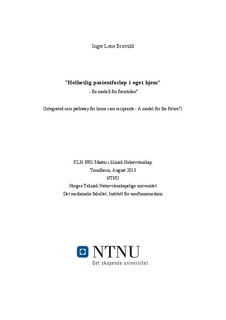Helhetlig pasientforløp i eget hjem - En modell for framtiden?
Abstract
Background: Discharge planning and follow-up in the patients’ homes shows positive effects
on readmission rates and unwanted incidents such as medication errors. The municipality of
Trondheim has, in cooperation with NTNU, municipalities and hospitals in Central Norway,
developed and implemented a common patient-centered care pathway, “Helhetlig
pasientforløp i eget hjem” (HPH), to meet the needs of multi-morbid home care recipients.
Purpose: The purpose of this study is to explore the patients’ satisfaction with home care
services, and the experiences of nurses/aides in regards to the implementation and daily use of
HPH. Material and methods: This qualitative study used in-depth interviews with patients,
and semi-structured focus group interviews with nurses/aides in the home care service in the
municipality of Trondheim. Results: The main finding is that patients are generally satisfied
with home care services, but are critical to the number of nurses/aides visiting. Nurses/aides
believe that the implementation of HPH has led to better observation, better documentation
and quality assurance. They say that HPH ensures equal follow-up regardless of which home
service unit the patient receives service from. At the same time the nurses/aides are critical to
the time and resources needed to conduct HPH properly, and are afraid that HPH reduces time
available directly to the patients. Conclusion: Patients are generally satisfied with home care
services. HPH improves quality and ensures more equal follow-up, but is time consuming and
might be at the expense of time available directly to the patients and thus cause difficult
prioritization. Relevance: The findings of this study indicate that HPH is a tool that yields
positive results. Further this study indicates that HPH should be recommended to other
municipalities, as it gives a common basis that ensures health services of good quality.
